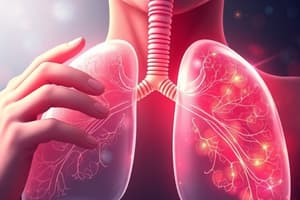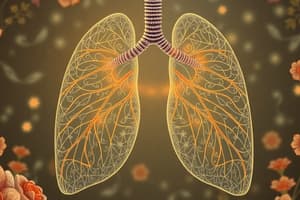Podcast
Questions and Answers
What is the primary purpose of using bronchodilators in COPD management?
What is the primary purpose of using bronchodilators in COPD management?
- To prevent allergic reactions
- To improve lung function and relieve symptoms (correct)
- To reduce inflammation in the lungs
- To enhance cardiac function
Under what condition might inhaled corticosteroids (ICS) be used in COPD treatment?
Under what condition might inhaled corticosteroids (ICS) be used in COPD treatment?
- When benefits outweigh potential adverse effects (correct)
- Only in patients with mild symptoms
- To solely relieve acute bronchospasm
- When they are the first-line treatment option
Which of the following is an important aspect of patient management for those on multiple pulmonary medications?
Which of the following is an important aspect of patient management for those on multiple pulmonary medications?
- Avoiding any follow-up consultations
- Encouraging patients to adjust dosages independently
- Frequent changes in medication regimens without monitoring
- Detailed instructions and counseling to improve adherence (correct)
Why is regular monitoring of lung function important in COPD treatment?
Why is regular monitoring of lung function important in COPD treatment?
Which class of medications is frequently used for maintenance therapy in COPD patients?
Which class of medications is frequently used for maintenance therapy in COPD patients?
What is the primary action of bronchodilators in the treatment of respiratory conditions?
What is the primary action of bronchodilators in the treatment of respiratory conditions?
Which type of bronchodilator is specifically designed for short-term relief of bronchospasm?
Which type of bronchodilator is specifically designed for short-term relief of bronchospasm?
Which medication is an example of a long-acting beta2-agonist used for maintenance therapy?
Which medication is an example of a long-acting beta2-agonist used for maintenance therapy?
What common side effect can occur when using beta2-agonists?
What common side effect can occur when using beta2-agonists?
What is the primary benefit of using inhaled corticosteroids in asthma treatment?
What is the primary benefit of using inhaled corticosteroids in asthma treatment?
Which class of drugs is used to block leukotrienes in managing inflammation in asthma?
Which class of drugs is used to block leukotrienes in managing inflammation in asthma?
Which of the following is a characteristic of tiotropium bromide?
Which of the following is a characteristic of tiotropium bromide?
What is the primary role of mast cell stabilizers in pulmonary pharmacology?
What is the primary role of mast cell stabilizers in pulmonary pharmacology?
Flashcards
Bronchodilator
Bronchodilator
A type of medicine that helps open up the airways in the lungs, providing relief from shortness of breath.
Inhaled Corticosteroid (ICS)
Inhaled Corticosteroid (ICS)
A type of medication that reduces inflammation in the airways, helping to prevent asthma symptoms.
Long-acting bronchodilator
Long-acting bronchodilator
A type of medicine that helps relax the muscles around the airways, providing relief from shortness of breath.
Inhaled Corticosteroid (ICS) for COPD
Inhaled Corticosteroid (ICS) for COPD
Signup and view all the flashcards
Patient Education and Medication Management
Patient Education and Medication Management
Signup and view all the flashcards
Pulmonary Pharmacology
Pulmonary Pharmacology
Signup and view all the flashcards
Beta2-agonists
Beta2-agonists
Signup and view all the flashcards
SABAs (Short-acting Beta2-agonists)
SABAs (Short-acting Beta2-agonists)
Signup and view all the flashcards
LABAs (Long-acting Beta2-agonists)
LABAs (Long-acting Beta2-agonists)
Signup and view all the flashcards
Anticholinergics
Anticholinergics
Signup and view all the flashcards
Anti-inflammatory Agents
Anti-inflammatory Agents
Signup and view all the flashcards
Study Notes
Pulmonary Pharmacology Overview
- Pulmonary pharmacology studies drugs affecting lung structure, function, and diseases.
- This field covers a broad range of treatments, from infections to COPD and asthma.
- Bronchodilators and anti-inflammatory agents are key components of pulmonary pharmacology.
Bronchodilators
-
Bronchodilators relax bronchial smooth muscles, improving airflow.
-
Two main classes are beta2-agonists and anticholinergics.
- Beta2-agonists: These drugs stimulate beta2 receptors in the lungs, leading to bronchodilation.
-
Short-acting beta2-agonists (SABAs) rapidly relieve bronchospasm, often used for acute exacerbations. Examples include albuterol and levalbuterol.
-
Long-acting beta2-agonists (LABAs) provide prolonged bronchodilation, used for maintenance therapy and prevention. Examples include salmeterol and formoterol.
-
Side effects may include tachycardia, tremor, and anxiety.
- Anticholinergics: These drugs block acetylcholine's effect on muscarinic receptors, reducing bronchoconstriction.
-
Ipratropium bromide is a short-acting anticholinergic for acute bronchospasm relief.
-
Tiotropium bromide is a long-acting anticholinergic for COPD maintenance therapy.
-
Potential side effects include dry mouth, blurred vision, and urinary retention.
Anti-inflammatory Agents
-
Anti-inflammatory agents are essential for managing chronic lung diseases like asthma and COPD.
-
Corticosteroids are powerful anti-inflammatory agents. Inhaled corticosteroids (ICS) target the airways, minimizing systemic side effects.
-
Examples of ICS include fluticasone, budesonide, and mometasone.
-
Leukotriene modifiers block leukotriene synthesis or action, reducing inflammation.
-
Examples include montelukast and zafirlukast.
-
Other Agents: Mast cell stabilizers like cromolyn sodium are also used in certain situations.
Asthma Pharmacotherapy
- Asthma treatment combines bronchodilators and anti-inflammatory agents, following a stepwise approach based on severity.
- Initial treatment often includes a SABA for rapid symptom relief.
- Moderate to severe asthma may need an ICS and/or LABA for long-term control, with a SABA as a rescue inhaler.
COPD Pharmacotherapy
- COPD management uses a combination of bronchodilators and anti-inflammatory agents to improve lung function, relieve symptoms, and prevent exacerbations.
- Long-acting bronchodilators (beta2-agonists and anticholinergics) are commonly used for maintenance therapy.
- Inhaled corticosteroids (ICS) may be beneficial but with careful consideration of the risks.
- ICS are not always the primary choice for COPD due to possible adverse effects. Benefits must outweigh these risks.
Other Important Considerations
- Patients taking multiple medications for pulmonary disorders need detailed instructions and counseling to improve adherence and minimize drug interactions.
- Medication use should be individualized based on patient's condition and response.
- Monitoring lung function and adverse effects is critical.
- Recognizing and addressing medication side effects is essential.
- Patient education on inhaler technique is crucial for optimal drug delivery and efficacy, and appropriate follow-up care should be ensured.
Studying That Suits You
Use AI to generate personalized quizzes and flashcards to suit your learning preferences.




